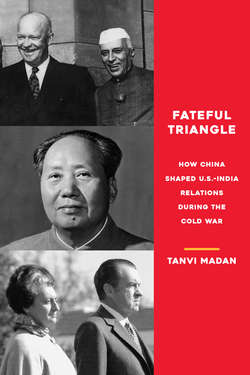Читать книгу Fateful Triangle - Tanvi Madan - Страница 9
1 The Orientation in the Orient (1949–1952)
ОглавлениеDivergences between United States and Indian views toward China and Indochina are serious foreign policy conflicts blocking closer understanding with India.
—Department of State policy statement, December 1, 19501
On October 11, 1949, at 4:40 p.m., Indian prime minister Jawaharlal Nehru stepped off US president Harry Truman’s plane Independence onto the tarmac at Washington’s National Airport. Time called it “one of the century’s most important visits of state.”2 It was Nehru’s first visit to the United States and the first summit level meeting between the American and Indian heads of government. Truman, along with three cabinet ministers and a 19-gun salute, greeted Nehru at the airport. The skies were cloudless; from Truman’s perspective, however, the state of the world was not. Just ten days earlier, Chinese Communist Party chairman Mao Zedong had announced the establishment of the People’s Republic of China. This “loss” of China shaped the welcome Nehru received in the US, put the subject on the Truman-Nehru agenda and affected how India and her prime minister were seen in the US.
Despite the sunny beginning that day, China cast a dark shadow on the US-India relationship in the few years after the Truman-Nehru meeting. From 1949 to 1956, American and Indian policymakers differed over the nature of the China threat, its urgency, and how to deal with it—and this posed a major challenge for US-India relations. American officials saw China as hostile and sought to contain it. The dominant view in India, however, was that China did not pose an external threat in the short to medium term; Delhi consequently sought to engage Beijing.
This US-India difference had an impact on their bilateral relationship because each country came to see the other’s China stance as, at best, hindering or, at worst, harming its own strategic priorities. Moreover, as the US focused more on Asia, and India played a larger role on the global—and especially Asian—stage, the two countries crossed paths frequently on the China question. Simultaneously, however, each country’s strategic framework, including vis-à-vis China, envisioned a role for the other. This perception prevented a complete US-India breakdown.
From the American perspective, China had two key effects on the US-India relationship. On the one hand, communist China’s emergence made India a bigger blip on Washington’s radar—one that stood out because of its size and potential as well as its noncommunist and democratic character. On the other hand, Delhi’s disagreement with American perception of and policy on China contributed significantly to tensions in the US-India relationship and, especially, the negativity or indifference India faced in the US Congress between 1949 and 1956.
China also shaped the US-India relationship in two key ways from India’s perspective. Differences on China led key Indian policymakers to see the US more as part of the problem in Asia than as part of the solution. Nehru thought the American attitude and actions toward China were destabilizing Asia. The resultant insecurity would require higher Indian defense expenditures and disrupt development, which was a key priority for his fledgling government. Simultaneously, however, Delhi saw the US as indispensable to facilitating Indian economic development—which Nehru believed was essential for India’s long-term security, including against China.
This chapter looks at the first phase of this period of divergence, that is, until 1952. It briefly considers how Washington viewed China and India in the period between the latter’s independence in 1947 and the communist takeover of China in 1949, and it outlines the link between those perceptions. It then considers Delhi’s views of a transitioning China and the US in the same period. The next section explores the differences that developed between the US and India on China after Mao came to power. Subsections consider India’s unwillingness to serve as a bulwark against China, US-India disagreement about recognizing communist China in 1949, their differences on the Chinese role in the onset of the Korean War in 1950, Beijing’s takeover of Tibet, American and Indian reactions to direct Chinese intervention in the Korean War, and the frustrations that developed as India served as an intermediary between China and the US during that war. The chapter ends with a look at how the differences that had developed on China affected American perceptions of—and willingness to aid—India.
